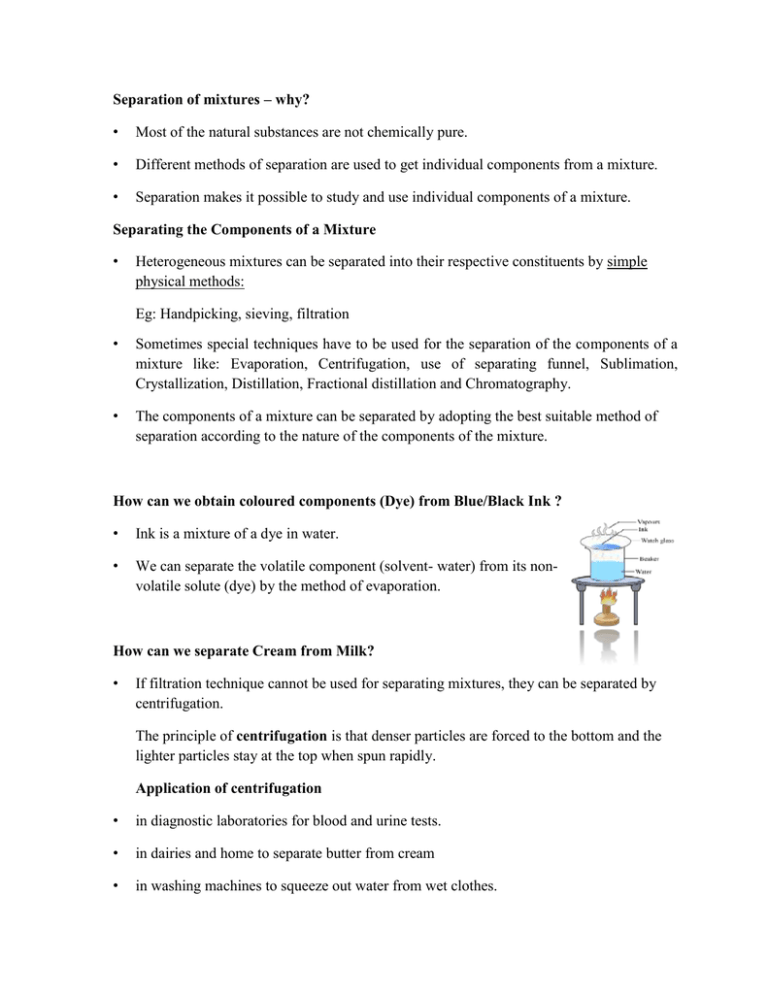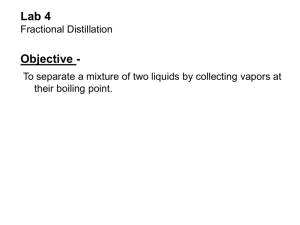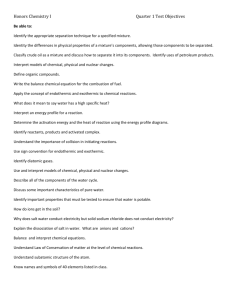File - Write your notes
advertisement

Separation of mixtures – why? • Most of the natural substances are not chemically pure. • Different methods of separation are used to get individual components from a mixture. • Separation makes it possible to study and use individual components of a mixture. Separating the Components of a Mixture • Heterogeneous mixtures can be separated into their respective constituents by simple physical methods: Eg: Handpicking, sieving, filtration • Sometimes special techniques have to be used for the separation of the components of a mixture like: Evaporation, Centrifugation, use of separating funnel, Sublimation, Crystallization, Distillation, Fractional distillation and Chromatography. • The components of a mixture can be separated by adopting the best suitable method of separation according to the nature of the components of the mixture. How can we obtain coloured components (Dye) from Blue/Black Ink ? • Ink is a mixture of a dye in water. • We can separate the volatile component (solvent- water) from its nonvolatile solute (dye) by the method of evaporation. How can we separate Cream from Milk? • If filtration technique cannot be used for separating mixtures, they can be separated by centrifugation. The principle of centrifugation is that denser particles are forced to the bottom and the lighter particles stay at the top when spun rapidly. Application of centrifugation • in diagnostic laboratories for blood and urine tests. • in dairies and home to separate butter from cream • in washing machines to squeeze out water from wet clothes. How can we separate a mixture of two immiscible liquids? • Using a separating funnel. • The principle: Immiscible liquids separate out in layers depending on their densities. Applications of separating funnel • To separate mixture of oil and water • In the extraction of iron (the lighter slag is removed from the top by this method to leave the molten iron at the bottom in the furnace). How can we separate a mixture of salt and ammonium chloride • Ammonium chloride sublimes (changes directly from solid to gaseous state on heating). • To separate mixtures that contain a sublimable volatile component from a non-sublimable impurity (salt in this case), the sublimation process is used. • Some examples of solids which sublime are ammonium chloride, camphor, naphthalene and anthracene. Is the dye in Black Ink a single colour? • The ink that we use has water as the solvent and the dye is soluble in it. • Usually, a dye is a mixture of two or more colours. • Chromatography is the technique used for separation of those solutes that dissolve in the same solvent. Paper chromatography • Principle: As the water rises on the filter paper it takes along with it the dye particles. The coloured component that is more soluble in water, rises faster and in this way the colours get separated. • This process of separation of components of a mixture is known as chromatography. • Kroma in Greek means colour. Chromatography was first used for separation of colours. • With the advancement in technology, newer techniques of chromatography have been developed. Applications of chromatography To separate :- • Colours in dye • Pigment from natural colours • Drugs from blood How can we separate a mixture of two miscible liquids? • This method is called distillation. • It is used for the separation of components of a mixture containing two miscible liquids that boil without decomposition and have sufficient difference in their boiling points. How can we separate a mixture containing more miscible liquids? The method is fractional distillation • To separate a mixture of two or more miscible liquids for which the difference in boiling point is less than 25K, fractional distillation process is used. • The apparatus is similar to that for simple distillation, except that a fractionating column is fitted in between the distillation flask and the condenser. • A simple fractionating column is a tube packed with glass beads. The beads provide surface for the vapours to cool and condense repeatedly • Applications of fractional distillation: • for the separation of different gases from air • different factions from petroleum products How can we obtain different gases from Air? • Air is a homogeneous mixture of different gases. • Air can be separated into its components by fractional distillation. Separation of components of air • The air is compressed by increasing the pressure and is then cooled by decreasing the temperature to get liquid air. • This liquid air is allowed to warm-up slowly in a fractional distillation column, where gases get separated at different heights depending upon their boiling points. • If we want oxygen gas from air we have to separate out all the other gases present in the air Purification of solids • The crystallisation method is used to purify solids. • The salt we get from sea water can have many impurities in it. To remove these impurities, the process of crystallisation is used. • Crystallisation is a process that separates a pure solid in the form of its crystals from a solution. Crystallisation vs evaporation • Crystallisation technique is better than simple evaporation technique as: * Some solids decompose or some, like sugar, may get charred on heating to dryness. * Some impurities may remain dissolved in the solution even after filtration. On evaporation these contaminate the solid. How can we obtain pure Copper Sulphate from an impure sample? • By crystallisation • Take impure sample of copper sulphate in a china dish. • Dissolve it in minimum amount of water and filter out the impurities. • Evaporate water so as to get a saturated solution. • Cover the solution using a filter paper and leave it undisturbed to cool slowly at room temperature. • Crystallization occurs and Crystals of copper sulphate will be obtained in the china dish. Applications of crystallization • Purification of salt that we get from the sea water. • Separation of crystals of alum (phitkari) from impure samples. Water purification system in water works Physical change Vs Chemical change Physical change Temporary change Chemical change Permanent change Occurs without a change in the chemical Occurs with a change in the chemical composition of the substance. composition of the substance. No new substance is formed. One or more new substances are formed. The substance after the change is identical The substances formed after the change in nature to the substance before the is altogether different in nature to the change. substance before the change. Involves a change in only the physical May involve a change in the chemical properties of the substance (physical state, and physical properties of the substance. size, shape, etc) Most likely to be reversible. Most likely to be irreversible. Element: The term element was first used by Robert Boyle in 1661. Lavoisier was the first to establish an experimentally useful definition of an element, as: An element is the basic form of matter that cannot be broken down into simpler substances by chemical reactions. Elements are divided into metals, non-metals and metalloids. Metalloids are elements having intermediate properties between those of metals and nonmetals. PHYSICAL PROPERTY Physical State METALS NON-METALS Mostly solids Mostly solids or gases (Liquid -mercury) (Liquid -bromine) Lustrous Dull Density High Low Melting Point &boiling point High Low Hardness Hard Soft Malleability (ability to be Malleable Non-malleable Ductile Non-ductile Sonorous Non-sonorous Heat Conductivity Very good conductors of heat Poor conductors of heat Electrical Conductivity Very good conductors of electricity Poor conductors of electricity Metallic lustre (having a shining surface) beaten into thin sheets) Ductility (ability to be drawn into thin wires) Sonority (ability to produce a ringing sound on striking a hard surface)








